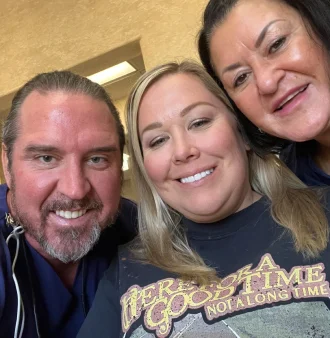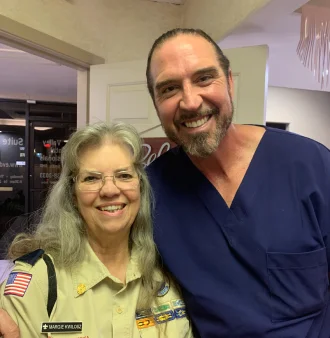Root Canals
(Endodontic Therapy)
Endodontic therapy, commonly referred to as a root canal, is used to fix and save a tooth that is infected or otherwise severely damaged.
Benefits
- Restores Normal Function: After a root canal, the tooth is restored with a crown or filling, allowing for normal chewing and full functionality.
- Pain Relief: Root canal therapy effectively relieves pain caused by deep decay or infection within a tooth.
- Infection Elimination: The procedure removes infected or inflamed tissue from the tooth, preventing the spread of infection to other teeth.
- Tooth Preservation: A root canal saves the natural tooth, avoiding the need for extraction and replacement with artificial alternatives.
- Prevents Jawbone Degradation: Maintaining the natural tooth helps prevent the jawbone from deteriorating, which can occur if the tooth were extracted.
- Enhances Oral and Overall Health: Treating and sealing the tooth reduces the risk of further infection, contributing to better oral and general health.
What people say
about Us
I've been a patient for fifteen years and I couldn't imagine going elsewhere. Everyone is professional, kind and the best of the best! I've had most every oral procedure and each has been flawless.
They are always friendly, attentive, have quick service and respond quickly to questions.
EVDP is amazing, the patient care is top notch and they do beautiful work! I felt so taken care of as patient and strongly recommend their services!
The visit was great I hope I can come up with the money some he can fix my mouth for me. At 53 have never had a kinder Dr. in my mouth. Wish I had insurance so he could do my work today.
Everyone was helpful and kind. I appreciate the introductions of who people were. My stay was pleasant and I'm hopeful my tooth problem is resolved.
Root Canal Treatment 101
The words “root canal,” send many dental patients into a state of panic. The truth is, root canal therapy done by a skilled dentist or endodontist is no more painful than getting a tooth filled. It’s better by far than the pain that caused you to seek dental treatment in the first place. Also known as endodontic treatment, The American Association of Endodontists estimates that around 22.3 million root canals, are performed annually. So, stop fearing, and start understanding how a root canal can keep you smiling.
What is a root canal?
Root canal, or endodontic therapy is used to repair and save a tooth that has been damaged or infected. Inside every tooth is a soft tissue area composed of nerves and blood vessels called the pulp. This is the “root” of the tooth. The root canal travels from the tip of the root into center of the tooth.
When the pulp becomes inflamed or infected, it needs to be removed. When pulp is damaged, bacteria begin to multiply causing an infection referred to as an abscessed tooth. An abscess is a pus-filled pocket that forms at the end of a tooth’s root. During a root canal procedure, the infected or dying pulp is removed, the pulp chamber and root canals are disinfected, and then the pulp is replaced with a filling and sealing material.
Why did my dentist suggest endodontic treatment?
If damaged or infected pulp is not removed, the areas around the tooth can become infected as well. Bacteria can damage the bone that holds the tooth to the jaw. Swelling and infection can spread to other areas of the face.
In the past, if a tooth was diseased or injured it was pulled. When a tooth is removed and not replaced, the teeth around it may shift making biting, chewing and cleaning your teeth harder. Today, a root canal treatment can save the tooth. Dentists know it’s better to save your natural tooth is better for your mouth than replacing it with bridges or dentures.
A step by step guide to root canal treatment
Root canal therapy can often be done in a single appointment, but occasionally two or three appointments may be necessary. Depending on the difficulty of the procedure, based on your individual situation, your dentist may choose to perform the procedure himself or recommend an endodontist, who specializes in this type of treatment.
- The first thing your dentist or endodontists will do is take an x-ray to discover the shape of your tooth’s root canals and spot any signs of infection in the surrounding bone. This will help them map out how the procedure should continue.
- Before beginning the endodontic procedure, your dentist will use local anesthesia to numb the area around the tooth. They will place a rubber dam around the tooth to keep it dry and free of saliva.
- The next step your dentist will take is to drill an access hole into the tooth on either the chewing surface or tongue side of the tooth. The infected pulp will be removed through this access point.
- Dead and infected pulp is cleaned out with a series of files of increasing diameter worked down the full length of the tooth to scrape and clean the sides of your tooth’s root canals. Water or sodium hypochlorite is used to wash away the debris.
- Once the tooth is thoroughly cleaned, it needs to be sealed against further bacteria infection. Sometimes, a dentist will put medication to clear up any lingering infection inside the tooth and wait a week before sealing it up. A temporary filling will be used to seal the tooth. Other times, your dentist will choose to permanently seal it on the same day it is cleaned out. To fill the interior of the tooth, a sealer paste and a rubber like material called gutta-percha are placed into the cleaned out root canal. A filling is placed in the exterior access hole your dentist created to perform the procedure.
- Because hollowing out the tooth leaves it more fragile, the final step often involves placing a crown or crown and post on the tooth to protect it from breaking and restore it to full function.
If your endodontic therapy is spread out over multiple office visits, it’s a good idea to minimize chewing on the tooth under repair to avoid recontamination or breakage before the tooth is fully repaired. Once a root canal is performed, you should feel relief from pain and be able to resume normal biting and chewing without discomfort. Remember, good oral hygiene can help prevent problems in the future.
What are the symptoms of dental pulp damage?
A tooth’s pulp can become irritated, inflamed, and infected due to deep decay, large fillings, or trauma to the face causing a crack or chip in the tooth. These things allow bacteria to enter the tooth pulp.
Signs you may need endodontic treatment include:
- Pain when chewing.
- Prolonged sensitivity to hot or cold temperatures, even after the source is removed.
- Darkening or discoloration of the tooth.
- A persistent sore on the gums.
Seek treatment right away
Don’t let fear of a root canal keep your smile from being its best. If you have severe or prolonged dental pain, don’t wait to schedule a visit with your dentist. Delaying can cause further damage to your tooth and jaw bone. We use the latest tools and procedures to make your root canal quicker than ever. Patients are often surprised how relatively comfortable the procedure is. East Valley Dental Professionals can provide the endodontic therapy you need to save an infected tooth from further damage and live pain free. We accept most dental insurance plans.
Use our online scheduler or call 480-838-3033 to schedule an appointment today.
Your Smile's Happy Place! Come visit us and see why
Fun atmosphere, friendly staff, and zero dentist nightmares


















